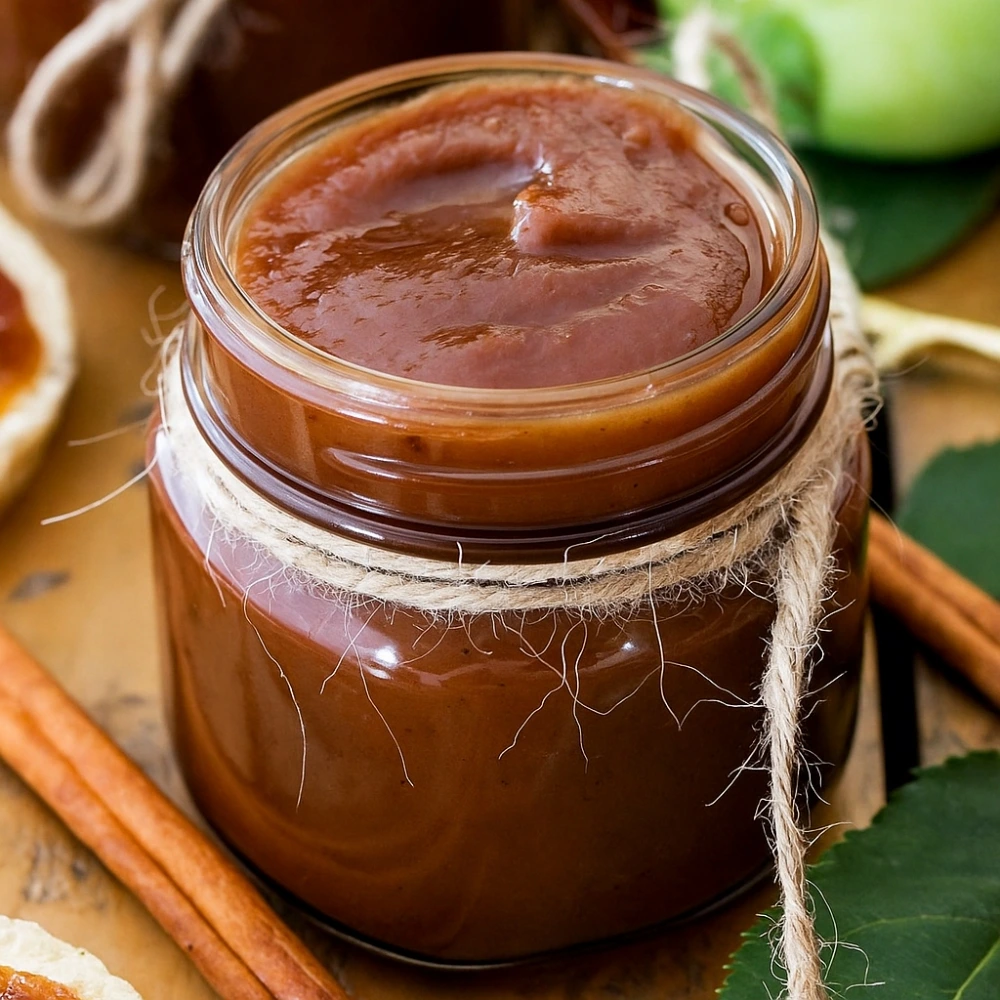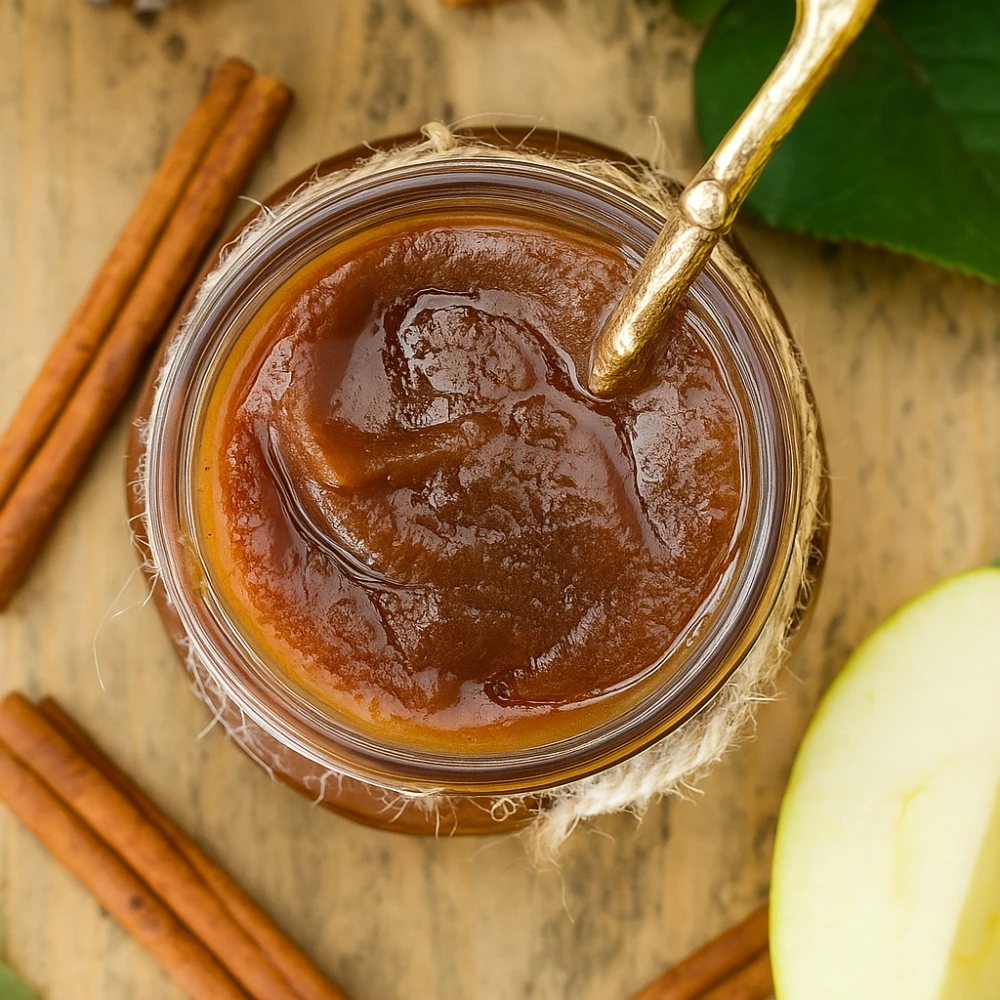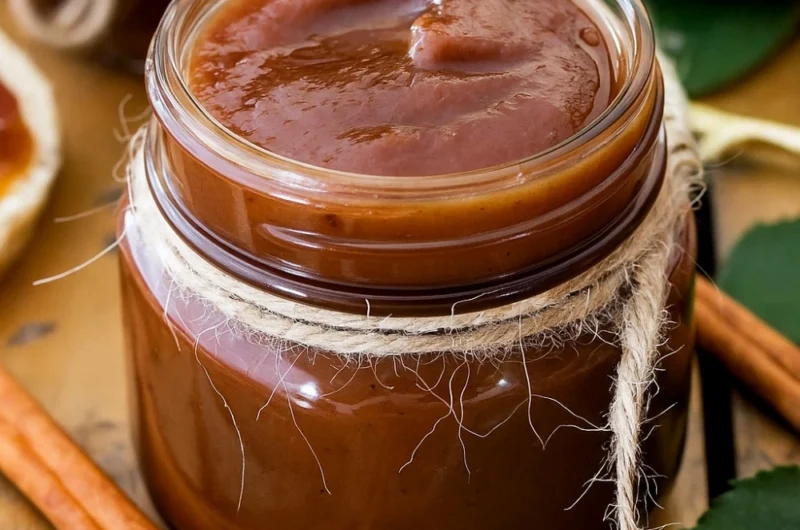The Best Fluffy Pancakes recipe you will fall in love with. Full of tips and tricks to help you make the best pancakes.
Guide to Homemade Apple Butter: Recipes, Science, & Storage

There’s something magical about opening a jar of homemade apple butter on a crisp autumn morning. That rich, velvety spread with its deep caramel notes and warm spice aroma instantly transforms ordinary toast into something extraordinary. Last fall, I made my first batch using apples from a local orchard, and I haven’t bought store-bought apple butter since. The difference in flavor, texture, and quality is simply incomparable.
In this comprehensive guide, you’ll discover everything you need to master the art of apple butter making—from selecting the perfect apples to troubleshooting common issues, plus detailed recipes for stovetop, slow cooker, and Instant Pot methods. Whether you’re a seasoned canner or a complete beginner, you’ll find actionable tips and science-backed techniques to create the smoothest, most flavorful apple butter you’ve ever tasted.
Why Make Your Own Apple Butter?
Creating homemade apple butter offers numerous advantages over commercial varieties:
- Superior Flavor Control: Adjust sweetness, spice levels, and texture to your exact preferences
- Clean Ingredients: No preservatives, artificial colors, or high-fructose corn syrup
- Cost-Effective: Transform abundant fall apples into multiple jars at a fraction of retail prices
- Gifting Potential: Beautifully jarred apple butter makes thoughtful, homemade presents
- Preservation Skills: Master a traditional food preservation technique that connects you to culinary heritage
The process is surprisingly simple, requiring just apples, sweetener, spices, and patience. The reward? A concentrated spread that captures autumn’s essence in every spoonful.
Choosing the Best Apples for Apple Butter
Not all apples are created equal when it comes to making apple butter. The ideal apple variety balances sweetness, acidity, and pectin content to create a naturally thick, flavorful spread.
Top Apple Varieties for Apple Butter
| Apple Variety | Flavor Profile | Best Characteristic |
|---|---|---|
| Granny Smith | Tart, crisp | High pectin, excellent thickening |
| Fuji | Sweet, dense | Natural sweetness reduces added sugar |
| Honeycrisp | Sweet-tart, juicy | Complex flavor depth |
| Gala | Mild, sweet | Smooth texture when cooked |
| Jonathan | Tangy, aromatic | Traditional apple butter flavor |
| McIntosh | Soft, slightly tart | Breaks down easily, creamy texture |
Pro Tip: The best apple butter recipe uses a blend of varieties. Combine 50% sweet apples (Fuji, Gala) with 30% tart apples (Granny Smith, Jonathan) and 20% aromatic apples (Honeycrisp, McIntosh) for balanced, complex flavor.
What Makes Certain Apples Better?
The science behind apple selection involves three key factors:
- Pectin Content: Natural pectin helps the butter thicken without additives. Tart apples typically contain more pectin.
- Sugar Concentration: Naturally sweeter apples reduce the need for added sugar during cooking.
- Texture When Cooked: Apples that break down smoothly create velvety apple butter without excessive processing.
The Science Behind Perfect Apple Butter
Understanding the chemistry of apple butter making elevates your results from good to exceptional.
The Maillard Reaction
As apples cook slowly over extended periods, the Maillard reaction occurs—a chemical reaction between amino acids and reducing sugars that creates:
- Deep brown color
- Complex caramel notes
- Rich, concentrated apple flavor
- Aromatic compounds that make apple butter smell incredible
This reaction requires low heat and long cooking times, typically 2-4 hours depending on your method.
The Pectin Factor
Pectin is a natural carbohydrate found in apple cell walls that acts as a thickening agent. As apples cook down:
- Cell walls break down, releasing pectin
- Acid (from tart apples or added lemon juice) activates pectin
- Sugar helps pectin molecules bind together
- The mixture transforms from applesauce to thick, spreadable butter
“The key to perfect apple butter texture is patience. Rushing the process by increasing heat prevents proper pectin development and caramelization.” — Food Science Institute
Apple Butter Recipes: Pick Your Method!
Choose the cooking method that fits your schedule and equipment. Each produces excellent results with slightly different advantages.
Classic Stovetop Apple Butter Recipe
Best for: Hands-on cooks who enjoy traditional methods
Prep Time: 20 minutes
Cook Time: 3-4 hours
Total Time: 4 hours 20 minutes
Yield: 4-5 cups
Ingredients
- 5 lbs mixed apples, peeled, cored, and chopped into 1-inch pieces
- 1 cup granulated sugar (or coconut sugar)
- 1 cup packed brown sugar
- 2 tablespoons ground cinnamon
- 1 teaspoon ground nutmeg
- ½ teaspoon ground cloves
- ¼ teaspoon ground allspice
- ¼ teaspoon salt
- 1 tablespoon vanilla extract
- 2 tablespoons fresh lemon juice
Instructions
- Cook the Apples: Place chopped apples in a large, heavy-bottomed pot. Add ½ cup water. Cover and cook over medium heat for 15-20 minutes, stirring occasionally, until apples are completely soft.
- Blend Until Smooth: Use an immersion blender to puree the cooked apples until completely smooth. Alternatively, transfer to a regular blender in batches.
- Add Sweeteners and Spices: Stir in both sugars, cinnamon, nutmeg, cloves, allspice, and salt. Mix thoroughly.
- Begin Slow Cooking: Reduce heat to low. Cook uncovered, stirring every 15-20 minutes to prevent sticking and burning on the bottom.
- Monitor Thickening: Continue cooking for 2.5-3.5 hours, or until the mixture is thick, dark, and reduced by half. It should mound on a spoon and not be watery.
- Finish with Flavor: Remove from heat. Stir in vanilla extract and lemon juice.
- Test Consistency: Place a small amount on a chilled plate. If no liquid separates around the edges, it’s ready.
Storage: Transfer to sterilized jars and refrigerate up to 3 weeks, freeze up to 6 months, or can using proper water bath canning techniques.
Easy Slow Cooker Apple Butter
Best for: Set-it-and-forget-it convenience
Prep Time: 15 minutes
Cook Time: 8-10 hours
Total Time: 10 hours 15 minutes
Yield: 5-6 cups
Ingredients
- 6 lbs mixed apples, peeled, cored, and chopped
- 1½ cups sugar (adjust to taste)
- 2 tablespoons ground cinnamon
- 1 teaspoon ground nutmeg
- ½ teaspoon ground cloves
- ¼ teaspoon salt
- 2 tablespoons apple cider vinegar
Instructions
- Fill Slow Cooker: Add all chopped apples to a 6-quart slow cooker.
- Add Seasonings: Sprinkle sugar, cinnamon, nutmeg, cloves, and salt over apples. Stir to combine.
- Cook on Low: Cover and cook on LOW for 8-10 hours, stirring occasionally if possible.
- Blend: After 8 hours, apples should be very soft. Use an immersion blender to puree until smooth.
- Thicken Uncovered: Remove lid and continue cooking on LOW for 1-2 additional hours to thicken and concentrate flavors.
- Finish: Stir in apple cider vinegar. Taste and adjust sweetness if needed.
Pro Tip: The slow cooker apple butter method produces the deepest flavor because the extended cooking time maximizes caramelization.

Quick Instant Pot Apple Butter
Best for: Fast results with minimal monitoring
Prep Time: 15 minutes
Cook Time: 45 minutes
Total Time: 1 hour
Yield: 4 cups
Ingredients
- 4 lbs mixed apples, peeled, cored, and chopped
- ¾ cup brown sugar
- 1 tablespoon ground cinnamon
- ½ teaspoon ground nutmeg
- ¼ teaspoon ground ginger
- Pinch of salt
- 1 tablespoon lemon juice
- ½ cup apple cider or water
Instructions
- Combine Ingredients: Add all ingredients to Instant Pot and stir.
- Pressure Cook: Close lid, set valve to sealing. Cook on HIGH pressure for 10 minutes.
- Natural Release: Allow 10-minute natural pressure release, then quick release remaining pressure.
- Blend: Use immersion blender to puree until completely smooth.
- Reduce: Switch to SAUTÉ mode. Cook uncovered, stirring frequently, for 20-30 minutes until thickened to desired consistency.
Note: While faster, Instant Pot apple butter has lighter color and less caramelized flavor than slow-cooked methods.
Ingredients & Flavor Variations
Customize your homemade apple butter with these creative variations:
Sweetener Options
- Maple Syrup: Adds depth and fall flavor (use ¾ cup per 5 lbs apples)
- Honey: Floral notes complement apples beautifully (use ¾ cup)
- Coconut Sugar: Caramel undertones, lower glycemic index
- Reduced Sugar: Use only ½ cup for a more tart, apple-forward spread
Spice Combinations
Traditional Autumn: Cinnamon, nutmeg, cloves, allspice
Chai-Spiced: Cardamom, ginger, black pepper, cinnamon
Apple Pie: Extra cinnamon with vanilla bean
Bourbon Barrel: Add 2 tablespoons bourbon after cooking
Ginger Snap: Fresh grated ginger and candied ginger pieces
Mix-In Ideas
- Caramel Apple Butter: Stir in ¼ cup caramel sauce
- Apple Cider Butter: Replace water with apple cider
- Vanilla Bean: Split and scrape one vanilla bean into mixture
- Citrus Zest: Add orange or lemon zest for brightness
Troubleshooting Common Apple Butter Issues
| Problem | Cause | Solution |
|---|---|---|
| Too thin/watery | Insufficient cooking time | Continue cooking uncovered to evaporate moisture |
| Too thick/stiff | Overcooked or too much pectin | Thin with apple cider or water, stir in while warm |
| Burned bottom | Heat too high or insufficient stirring | Always use low heat; stir every 15-20 minutes |
| Not sweet enough | Tart apple variety or insufficient sugar | Add sugar gradually; taste and adjust |
| Lacks depth | Insufficient cooking time | Ensure at least 2 hours for stovetop, 8 for slow cooker |
| Grainy texture | Apples not blended enough | Blend longer until completely smooth |
How to Store & Preserve Apple Butter
Proper storage ensures your apple butter maintains quality and safety.
Refrigeration
- Method: Store in clean, airtight containers
- Duration: 3-4 weeks
- Best for: Small batches you’ll use quickly
Freezing
- Method: Use freezer-safe containers or bags, leaving 1-inch headspace
- Duration: 6-12 months
- Best for: Long-term storage without canning equipment
- Tip: Freeze in small portions (½ cup) for convenient thawing
Water Bath Canning
For shelf-stable, long-term storage:
- Sterilize Jars: Wash half-pint or pint jars in hot, soapy water. Keep hot until ready to use.
- Heat Apple Butter: Bring apple butter to 190°F (just below boiling).
- Fill Jars: Ladle hot apple butter into hot jars, leaving ¼-inch headspace.
- Remove Air Bubbles: Run a non-metallic spatula around inside edges.
- Wipe Rims: Clean jar rims with damp cloth. Place lids and rings.
- Process: Process in boiling water bath for 10 minutes (pints) or 15 minutes (quarts), adjusting for altitude.
- Cool: Remove jars and cool completely. Check seals after 24 hours.
Storage: Properly canned apple butter lasts 12-18 months in a cool, dark place.
USDA Recommendation: Always follow current USDA canning guidelines for safe food preservation. Botulism risk is low in high-acid foods like apple butter, but proper technique is essential.
Creative Ways to Use Apple Butter (Beyond Toast!)
Expand your culinary horizons with these delicious applications:
Breakfast Ideas
- Swirl into oatmeal or yogurt
- Spread on pancakes, waffles, or French toast
- Mix into cream cheese for bagels
- Stir into smoothies for apple pie flavor
Savory Applications
- Glaze for Pork: Brush on pork chops or tenderloin during last 10 minutes of cooking
- Cheese Board: Pair with sharp cheddar, brie, or goat cheese
- Sandwich Spread: Add to turkey or ham sandwiches
- BBQ Base: Mix with tomato sauce for apple-sweetened BBQ sauce
Baking & Desserts
- Replace oil in baking (1:1 ratio) for moist, reduced-fat treats
- Fill thumbprint cookies or sandwich cookies
- Layer in parfaits with granola and yogurt
- Swirl into cheesecake or pound cake batter
- Fill crepes or blend into ice cream
Gift Ideas
Package homemade apple butter with:
- A fresh loaf of homemade bread
- Artisan crackers and cheese
- Recipe cards for use suggestions
- Decorative jars with fabric toppers and ribbon
Apple Butter FAQ
Q: What’s the difference between apple butter, apple sauce, and apple jam?
A: Apple butter is cooked much longer than applesauce, concentrating flavors and creating a thick, spreadable consistency. Apple jam contains added pectin and has a more gel-like texture with higher sugar content. Apple butter has the deepest flavor and darkest color due to extended caramelization.
Q: Do I need to add pectin to apple butter?
A: No. Apples contain natural pectin that activates during long, slow cooking. The extended reduction time naturally thickens the mixture without commercial pectin.
Q: Can I make apple butter without sugar?
A: Yes, though it will be more tart and less thick. Use naturally sweet apple varieties and add alternative sweeteners like apple juice concentrate, dates, or rely entirely on the apples’ natural sugars.
Q: Why is my apple butter too dark?
A: Very dark apple butter results from either very long cooking times (which intensifies flavor) or cooking at too high a temperature (which can cause burning). Both color and flavor are personal preferences—darker isn’t necessarily wrong.
Q: How do I know when apple butter is thick enough?
A: Place a small amount on a chilled plate. If no liquid separates around the edges and it mounds rather than spreads, it’s ready. It should be spreadable but not runny.
Q: Can I use a pressure canner instead of water bath?
A: Yes, but it’s unnecessary. Apple butter is high-acid, making water bath canning safe and appropriate. Pressure canning won’t harm it but doesn’t provide additional safety benefits.
Q: What’s the best way to prevent apple butter from sticking to the pot?
A: Use a heavy-bottomed pot, cook on low heat, and stir every 15-20 minutes. A long-handled wooden spoon helps reach corners where sticking commonly occurs.
Your Apple Butter Journey Starts Now
Creating homemade apple butter transforms simple ingredients into something extraordinary. Whether you choose the traditional stovetop method for hands-on control, the slow cooker for convenience, or the Instant Pot for speed, you’ll discover that making your own apple butter connects you to seasonal rhythms and time-honored preservation traditions.
The rich, concentrated flavor of apple butter you’ve made yourself simply cannot be replicated by store-bought versions. Each batch reflects your apple choices, spice preferences, and the patience you invested in the process.
What’s your favorite way to enjoy apple butter? Share your creative uses and favorite recipes in the comments below! And if you found this guide helpful, save it for apple season and share it with fellow food enthusiasts who appreciate the magic of homemade preserves.
Guide to Homemade Apple Butter: Recipes, Science, & Storage
Course: Desserts, Recipe CollectionsCuisine: American4
servings20
minutes2
hours40
kcalIngredients
5 pounds apples (peeled, cored, and chopped)
1 cup granulated sugar
1 cup brown sugar
2 teaspoons ground cinnamon
½ teaspoon ground nutmeg
¼ teaspoon ground cloves
½ teaspoon salt
1 tablespoon vanilla extract
Directions
- Peel, core, and chop the apples. Place them in a slow cooker or heavy-bottomed pot.
- Add both sugars, cinnamon, nutmeg, cloves, and salt. Stir well to coat the apples.
- Cook on low heat for 8–10 hours in a slow cooker or stovetop on very low for about 2 hours, stirring occasionally until apples are soft and dark brown.
- Blend the mixture with an immersion blender (or in batches in a regular blender) until smooth.
- Stir in the vanilla extract and cook uncovered for an additional 30 minutes to thicken.
- Let cool and transfer to sterilized jars or airtight containers.
- Store in the refrigerator for up to 2 weeks, or process in a water bath canner for longer shelf life.

